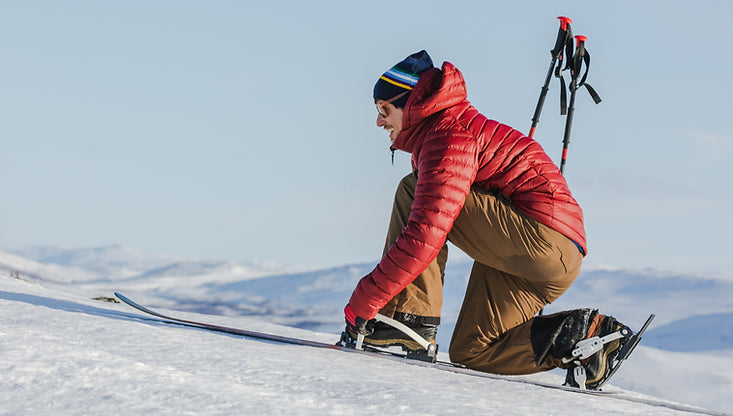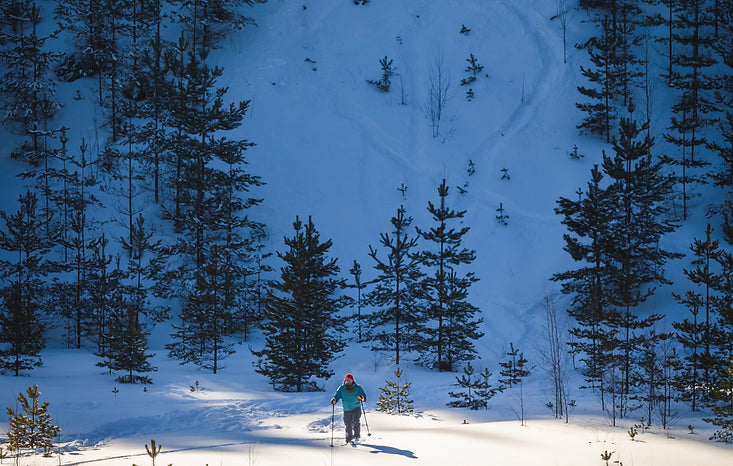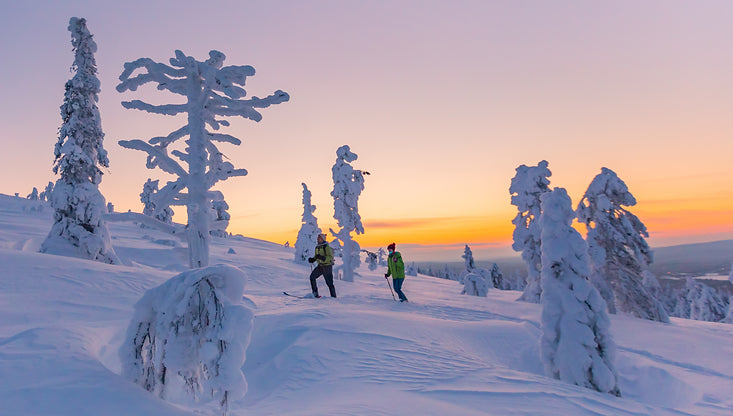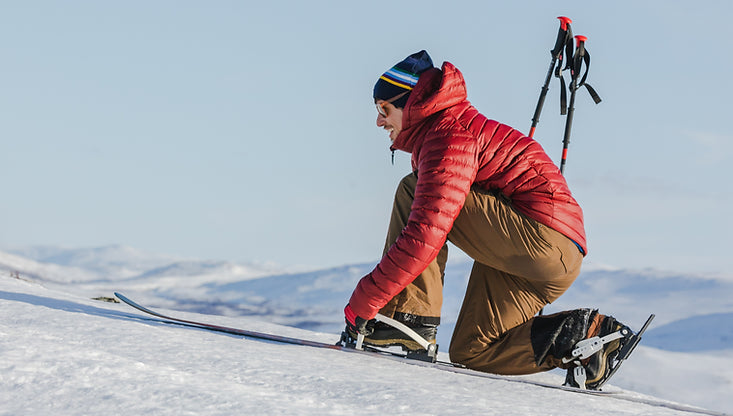We receive a lot of questions about what is the best footwear to use with our EA Universal Bindings. The answer? It depends! This week, we share our knowledge and expertise on the subject by discussing the different factors that can affect your footwear choice. Choosing the optimal shoe for your Skinbased adventures is determined by three main variables: the terrain, your skiing skills, and the temperature.

Before going through the variables, let’s begin with the basics. There are some functional features that are necessary for all footwear to have if you wish to use them with EA Bindings. First and foremost, the sole of the footwear must be flexible. The EA Binding mechanism is based on a flexing hinge, and that hinge can only flex freely when the sole of the shoe flexes with it.
Second, the more torsional rigidity (side-to-side support) the shoe has, the better. Torsional rigidity gives you better stability, especially in harder terrain, such as when going downhill. Third and equally important is ankle support. Good ankle support offers your joint some extra protection that can help to prevent injuries, as well as makes skiing more efficient and enjoyable.
Skiing Terrain

Once we have met the minimum requirements, it's time to refine our footwear choice to meet the specific needs of our Skinbased outing. Let’s start by discussing what our skiing goals for the day are. If your plan is simply to go out for a fun afternoon of snow trekking in the local park, or a casual ski tour across flat or mellow terrain, then the focus of footwear choice can move away from support, and shift more towards comfort and warmth. While having ankle and side-to-side support is still of importance, it is not as crucial when only mellow to moderate terrain is involved. Instead, focus on picking a shoe that is well broken-in, and will keep you warm and dry. For more tips on warm footwear, see our “Temperature” section below.
If you find yourself wanting to explore more challenging terrain, for example skiing laps at your favorite xc-downhill spot, then it is critical that your footwear choice have both a high level of ankle support and torsional rigidity. Choosing a highly supportive piece of footwear should be your priority as you head toward steeper and more difficult terrain. Not only will a supportive boot give you the ability to carve turns easier, it will keep your ski legs feeling fresher, longer.
Level of Skills and Personal Preference

Balance, stance, and getting the ski on edge: these are just a few of the many areas of ski-technique that can be improved by wearing the right footwear. All else being equal, the general rule of thumb is that the better your skiing technique, the less amount of support you will need from your footwear. Conversely, an increase in footwear support can help a less-experienced skier to feel more stable while changing lead skis, making turns, and even with basic balance, especially when on uneven terrain.
Personal preferences also play a role in your footwear choice. Oftentimes, these preferences are directly related to your own skiing and snow trekking experiences. The more time you have on your Skinbased skis, the better understanding you will have of the shoe requirements and how they work for you. There is not just one shoe that works for all people or situations. We recommend trying many different footwear options so that you will find the combination of shoe, technique, and terrain that best suits you and your level of skill.
Temperature

Nothing can ruin a fun day of Skinbased skiing faster than cold feet. The same shoe that works for sunny, spring snow trekking might not be appropriate for longer tours in the depths of winter. Consult the weather forecast before heading out so you know what to expect. For mild-temperature days, you can make your choice based more on your skill level and terrain choice. For colder days, consider the following:
- Wear softer, more flexible footwear, as this normally allows your feet to move more inside of them, increasing blood flow.
- Make sure your shoes are not overly-snug. Looser-fitting boots allow for a layer of air to be trapped between the boots’ uppers and your feet. This “dead air space” helps to insulate your feet, as well as allow the blood vessels in your feet to remain unrestricted.
- Consider using insulated footwear. Boots with an added synthetic fill, or even just a waterproof liner, can help to minimize heat loss.
- Choose the right sock. If your shoe or boot will allow it, use a thicker-than-normal, non-restrictive sock to help insulate your toes. Be sure to always choose a sock made from a wicking material such as merino wool or a synthetic fiber. Layering concepts also work with footwear, just as they do with other clothes (see the blog article: What to Bring on Your First Ski Outing). Thus, a thinner “liner sock”, often made of a fast-wicking synthetic fiber, worn under a thicker wool sock for warmth, is a great combination.
- An additional or thicker insole, especially those that incorporate wool into their construction, can also help keep your feet and toes warmer. Just as with using extra socks, be sure you have enough additional space to comfortably accommodate these into your shoes without creating a tight fit, which will restrict blood flow to your feet.
Taking into account the basic footwear requirements and the variables discussed above, you should now have the tools you need to choose the right piece of footwear for the Skinbased job at hand. Remember, that what might be the right boot for today, may not be the best one for tomorrow, so refer back to this list before stepping out the door to make sure you start off each Skinbased adventure on the right foot!
___
Related text: Boots and Bindings: The tools that connect you to your Skinbased ski

0 kommentarer